The Most Important Boat-Buying Tip of All
We test boats and try to give buyers as much information as possible to guide their buying decision into the right vessel for their needs. However, we regret to say that we rarely come to grips with the most important factor of all. Occasionally we obliquely mention it, but it is a difficult and problematical subject to discuss in public. That rarely mentioned factor is the character of the builder, or the president of the company. His or her attitude makes all of the difference when it comes to a consumer having a satisfactory experience with a boat. And the same thing holds true for the boat dealer. In most cases, the difference between a boater having a successful boat experience and a miserable one rests on the experience, character, and integrity of the boat builder and dealer. How can you tell which builders and dealers have those three important characteristics and which don’t? There is no sure-fire way, but we will give you one litmus test to use.
 This is a depiction from the ancient Egyptian “Book for the Dead” that goes back 4500 years or more. The deceased is being judged to determine if his soul will be allowed to proceed to the afterlife. If his heart is lighter than a feather, meaning he was a good man doing good deeds, he will be allowed to pass. You can perform the same test of boat builders and dealers in this life. We’ll show you how. |
For the last 41 years we have seen boat builders come and go, rise and fall, start up in business and go out of business. Given that power boating as a sport is only about 100 years old, 41 years is a significant percent of this movie. From our years of observation, the character and competence of the boat builder and dealer can spell the difference between a great experience and a nightmare.
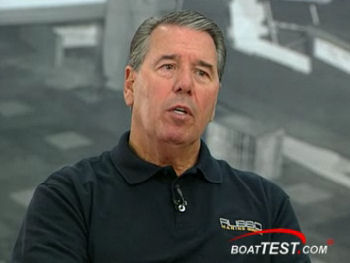 Larry Russo, of Russo Marine, a dealer all of this life, says that consumers need a dealer who they can rely upon and trust when they are in trouble. |
The Boat Builder
People start boat building companies for a lot of reasons, but virtually all do it because they like boats, think they have a better idea than the boats already being built, and because the cost of entry can be low. A number of now-famous and prestigious brands were started in a garage with another builder’s boat turned upside-down being used as a plug for the “new design.” But with success and the days of being thankful for customers – in some cases – turns in to disdain for whining, demanding, often litigious, customers.
Along the road somewhere from the garage to the large factory, a founder’s character, as well as business acumen, becomes tested. Boat builders, just like people in any other walk of life, diverge into different niches and their “reputations” evolve. Some grow into good reputations, and some go the other way, and of course there are all shades of gray in between.
The Hired President
More likely these days the president or general manager of a boat company is a person who did not start the company. These are people who worked their way up in an organization or were brought in from outside the boating industry. No matter what their skills and attitudes, one thing that few of these people have is the experience and elation of selling the first few boats and making sure those first few customers were happy. The hired presidents also missed the stress and the anxiety of the early days of the business when it struggles to make payroll and every sale was an important one. Most hired presidents have come in to run boat companies after the operation was going strong – or going down on the wrong side of the curve.
(The current Great Recession is teaching all managers both what it is like starting out, when each sale is precious, and each customer is heaven-sent. We suspect the last two years, and this one, too, will bring about a whole new approach in customer service by all builders and dealers. And, much needed in our opinion. But we are not there yet with all major builders.)
 Jeff Olson, President of Four Winns, explains the thinking behind the radical pickle-fork Four Winns models. |
New Generation
Today, about two-thirds of the boat companies are run by hired managers, as the founders have sold out or have been taken over by other companies for one reason or another. As a result, the large majority of boat builders these days are run by people who did not start them. In some cases, the boat brands are actually being run by people who know very little about boats.
But this does not mean that they lack character or are not good at what they do. Everybody had to come from somewhere, and we find auto industry executives, insurance salesmen, engineers, advertising executives, former pilots, and people from many other occupations running boat companies.
These days boat builders fall roughly into four general categories: 1) Family owned and operated; 2) Family owned with hired managers operating them; 3) Owned by a venture capital or financial investment firm and run by hired managers; 4) Publicly-traded companies that are run by hired managers or a major stock holder.
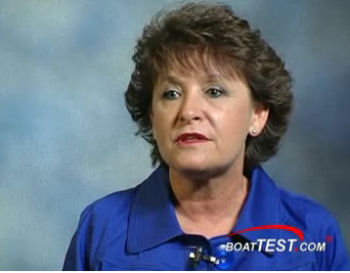 Kris Carroll, President of Grady-White, explains why Grady-White consistently wins the J.D. Powers award in class. |
It Rolls Down Hill
No matter what the ownership structure of a company, or the background of the person running it, we subscribe to the notion that the person at the top shapes the culture of a company. That person's attitude towards the product and the customer and about how both are handled starts at the top and seeps right down to the person who sweeps the shop floor. And since boat companies are all relatively small companies (even the largest boat-building factory employed no more than 1500 people in good times) it is obvious how quickly attitudes in the top manager's office get transmitted quickly to all.
Show us a brand with poor customer service, and we will show you a company president who really doesn’t care about the owners’ experience. Show us a boat where the cabinet doors are misaligned and don’t close right and we’ll show you a company president who either rarely ventures into the factory or if he does, doesn’t understand what is really going on.
 Duane Kuck, President of Regal, talks about Regal’s innovate program where large boats are not stocked by his dealers. |
The Chris-Craft Example
As a boat buyer there are no easy answers, and quite often once one has scoped out the character of a company’s top management, it has changed and there is all a new ball game. (One company, for example, has had five presidents in the last five years.) There is a classic example, one for the Harvard Business School text books, of top management whip-sawing a company: Chris-Craft.
Chris-Craft is one of the oldest and greatest names in boating. Chris Smith started building boats in 1884. He along with Gar Wood were involved in the development of powerboats in the early part of the 1900s when powerboat racing was a national rage. Chris-Craft was formally organized in 1924 and by the late 1920s Chris-Craft was building 1,000 mahogany runabouts a year.
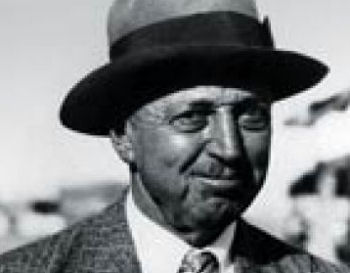 Christopher Columbus Smith (1861-1939) is largely responsible for power boating as we know it today – and he started the sport’s most iconic brand. |
Chris Smith died in 1939 and the company was taken over by his son and the business boomed in the 1950s as Chris-Craft led the boating industry in the post-war boom and in the development of the sport today as we know it. It made ever larger boats culminating in the Chris-Craft Constellation – the country’s first large production motoryacht.
Later the company was taken over by Chris Smith’s grandson for a short while before being sold. And that was the beginning of forty tortuous years of revolving-door ownership and management that was a roller coaster of product quality and customer service. The fit and finish of the boats produced during each ownership’s administration reflected the character and competence of the person in the director’s chair – and it swings from good to horrible.
Destruction of a Company
At its nadir, Chris-Craft was owned by a man alleged to be a West Virginia coal mine tycoon and who knew as much about boats as did Willy Sutton, nor did he particularly care about them. Like Sutton, it seemed all he was really interested in was mining the money from the company’s cash flow. (Q: Why buy Chris-Craft? A: That’s where the money is.)
Not surprisingly, the company disintegrated in just a few years. The once majestic Chris-Craft was building some of the worst boats in America. They were literally falling apart. Some were delaminating. Quality control had no control as one disaster after another was shipped to dealers who tried to fix them up as well as they could, then one by one threw in the towel. It took a few years, but it was not long until the word had spread to every marina and launch ramp in America by world of mouth – “stay away from Chris-Craft, buy anything but Chris-Craft.”
We will never forget a call we made to the man running Chris-Craft at the time. We had three letters on our desk from owners saying delaminations had happened to them, along with pictures. We asked him about problems with his catamarans. “That’s not happening, there are absolutely no problems” he said. The company imploded a couple of years later.
 Stephen Julius, Chairman of Chris-Craft, bought the brand, and like a phoenix, it has risen from the ashes. |
New Owner, New Management
About 10 years ago, just as BoatTEST.com was getting started, the rights to the Chris-Craft name were bought by Stephen Julius, an Oxford and Harvard-educated British entrepreneur who had made a career of buying up-market brands which had been run into the ground. He turned them around then sold them for a tidy profit. His most recent success had been Riva, the iconic Italian boat brand that was languishing on the shores of Lake Sarnico, Italy, having fallen from the very pinnacle of yacht building.
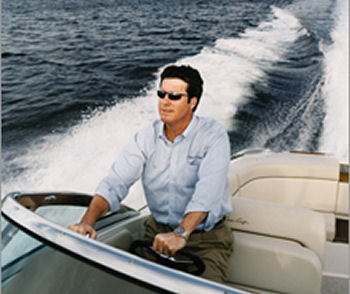 Steven Heese, President of Chris-Craft, has a positive attitude in the face of the worst recession since the big one. |
He, along with a Harvard classmate, Steven Heese, poured their hearts and minds (to say nothing of millions of dollars) into recapturing the old days of Chris-Craft boats of the 1930s and 1950s – but up-dating the vessels to take advantage of fiberglass and new technologies. The result was a completely new line of boats from the keel up, many of which are the most intricately-tooled fiberglass sportboats on the market then and still today.
Millions of dollars have gone into the building the Chris-Craft line and no production boat builder in America has anything close to them in terms of design, style and craftsmanship. They are expensive, but given the amount of investment it has taken Chris-Craft to get to this point, they are actually a bargain.
Julius and Heese are examples of two men who are dedicated to creating an exciting boating experience for the consumer. And while they undoubtedly got into the venture in hopes of turning the company around and selling it, the fact remains that they care passionately about boats, they respect the heritage of Chris-Craft, and they understand the finest traditions of boat building.
 Stephen Dougherty, President of Everglades, talks about his approach to building boats. |
Focus on The Man
Several years ago, mindful of the importance of the person at the boat-building helm, we interviewed a number of boat company presidents and general managers. The idea was to let them talk about issues in boating and to ask them what set their boats apart from the competition. It was a chance for them to put their best foot forward. Our secondary purpose was to put these people on video tape so that boat-buyers could see the cut of their jib. The camera is quite good at doing that.
Interestingly, the president of one of the largest boat companies in America when invited to be interviewed said, “What is in it for me?” That spoke volumes about this person’s approach to boat owners and even his own boat company. (He is no longer with the company.)
 Scott Porter, President of Formula Boats, explains his company’s 5-year warranty program. |
The Litmus Test
In order to get a feel for the culture at a company where you are going to invest a serious amount of your cash, we suggest that you call the company's president and ask the questions on your mind. Ask about who will be helping you learn about the boat and what the break-in period should be. Ask about warranty matters and what will happen if your engine goes bonkers. Ask what the boat builder will do if the engine-maker denies a warranty claim.
The answers to most of these questions will probably be that the dealer will take care of it – and they should -- but your next question should be, “What if the dealer doesn’t take care of it? Will you or your staff help when I am in trouble?”
 Paxton St. Clair, President of Cobalt Boats, says he takes all customer calls, and explains why. |
One thing we have learned after 41 years in the business is that the person running the boat company in most cases can do what it takes to make the customer happy if he/she chooses to do so. In some cases it might mean getting tough with an engine maker, and in other cases it may mean that the company will just have to suck it up and take a hit not budgeted for. And that is the rub. Middle managers and customer service people don’t want to bust their budgets – only the top dog can do that.
An Important Call
Your phone call before buying should keep you from having to make the phone call after buying.
Are the boat company presidents too busy to talk to a customer? Not if you are ready to buy. In case you haven’t heard, the Great Recession is going on and boat sales are often anywhere from 10% to 35% of what they were three or four years ago. That means that the makers of big boats are building less than 50 boats a year and the builders of small boats are only selling a couple of thousand or more likely only a few hundred. Most company presidents will be glad to take your call. And if you can’t get through, or get a call back, then you just got the answer to your most important question.
Editor’s Note: For those readers interested in what the appropriate hieroglyphics at the beginning of this article say in relation to the heart and feather, here is a translation from the Internet--
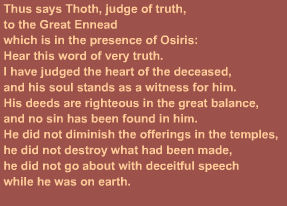 It seems like the human nature hasn't changed much over the years. The material above was written in 1375 B.C. |